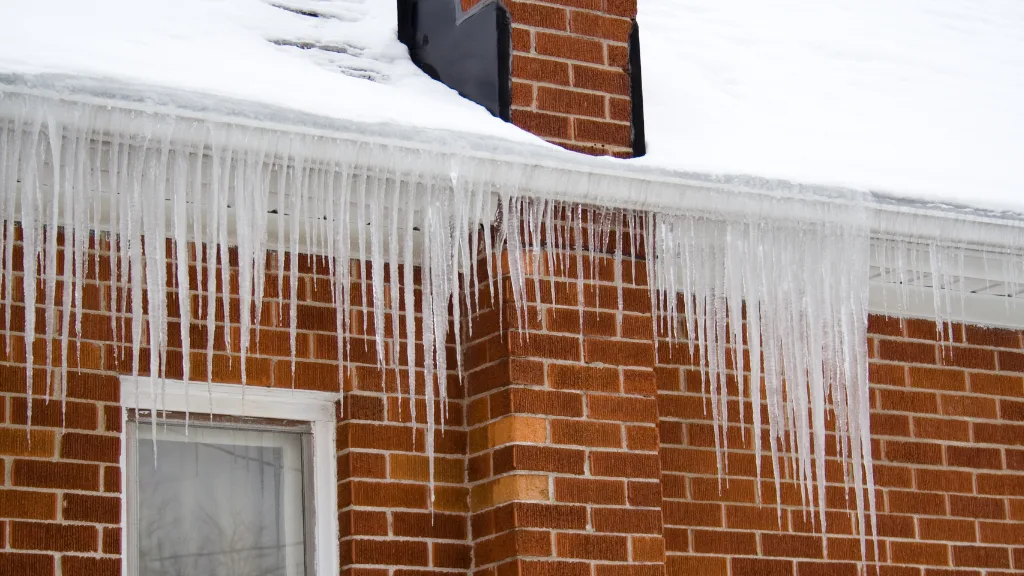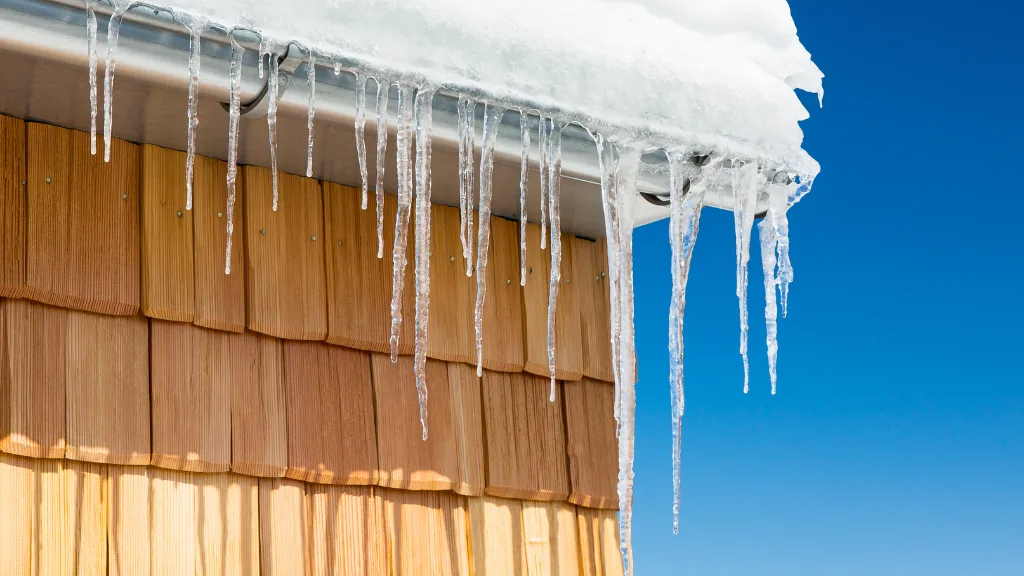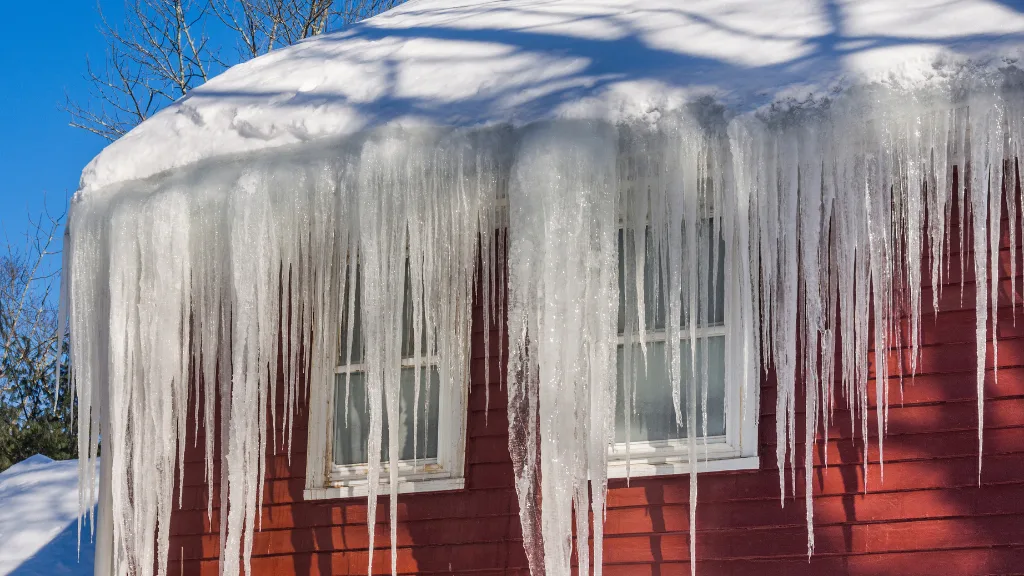
What are ice dams and how do they form? We get this question a lot at Ice Dam Guys.
Ice dams can be very dangerous, so it is important to understand what they are and how to deal with them before you have an issue on your hands.
An ice dam forms when there is snow on the roof of your home that melts during the day because of heat from within the attic or interior walls, then freezes at night as temperatures fall below freezing.
This causes water to back up behind the dam and leak into your house through any place where there’s an opening in your exterior walls or ceilings, like windowsills or venting registers.
The water leaks cause damage to drywall, insulation, carpeting, hardwood floors etc.
What is an Ice Dam?
Sometimes called “snow dams,” ice dams can cause serious damage to your home and property.
When the ice dam is under a roof shingle, it can tear part of the shingle away from your roof when trying to remove itself which causes leaks that rot wooden roof beams or ceiling joists.
An ice dam occurs in freezing temperatures when warmer air enters into an area where cold air exists. Warm air holds more moisture than cold air.
The warm moist air heads towards the ground and freezes when making contact with an area that’s below freezing, such as a snow covered roof in wintertime.
As opposed to what some people may think, ice dams aren’t caused by too much heat escaping from your home or poor insulation in your attic or walls.
In fact, ice dams can indicate you have too much insulation in your attic or not enough ventilation.

How to get rid of them?
If you have an ice dam on your roof, you can try using a de-icing product or hire someone who can repair it for you quickly before further damage occurs.
In the meantime, you can take a few precautions to keep this from happening in the future.
Make sure your roof is properly insulated with snow guards and ice shields. Snow guards are installed on top of your gutters to prevent snow from falling off too quickly.
Ice Shields are placed under the shingles to create a small barrier between them and the snow.
In addition, you can clear your roof of snow as soon as it falls and keep a close eye out for ice dams.
If you see one start to form, make a plan of action before it gets too large and causes damage. Once the ice dam is relatively small, you can take a few steps yourself to remove it:
- Climb onto your roof to remove the dam with a hand-held ice pick.
- Use your garden hose to spray down the dam, creating cracks in it so you can chip away at it.
The best way to prevent ice dams is by making sure your attic has plenty of ventilation. Add or replace insulation that’s compact and lacks air pockets, which can act as an insulator.
Make sure any vents near the peak of your roof are clear of obstructions like piles of snow.
- If you have existing ice damming problems on your roof, your best option is to call a professional roofer.
- This will ensure the problem gets fixed right away before it can cause more damage or be expensive to fix later on down the line.
- If you are looking for an easy home remedy that can help prevent ice dams from forming in wintertime, try spreading talcum powder over your snow-covered roof.
- Talcum powder is excellent for absorbing moisture and preventing ice from forming on the surface of your roof.
Ice dams can cause damage to insulation, ceilings or exterior walls in your home.
If you spot an accumulation of snow around the edge of your roof during wintertime, it’s a good idea to call up a professional before any major damage is done.
If these options seem too difficult or unsafe, call someone who can remove an ice dam for you without requiring access to your roof.
They will be able to use hot water or steam to melt the ice dam and keep it from growing.
Once you remove an ice dam, take preventative measures in the future to prevent them from forming again.
Also, don’t forget to remove snow efficiently so you do not have too much weight on your roof’s shingles in the first place.
How to Protect Your Roofing from Ice Dams
If you are concerned about ice dams, there are several ways to protect your roofing from damage.
- One way is to insulate your attic properly with the use of either cellulose insulation or spray foam insulation.
- Another option for protecting your home’s exterior wall and roofing system during wintertime is by using a radiant barrier product that reflects heat back to the source of heat, which is usually your home.
- If you are looking for a quick fix before calling in an expert, try sprinkling talcum powder on any snow-covered areas around your roof’s edge during wintertime.
- The talcum powder can help prevent ice dams from forming by absorbing moisture and preventing ice build up.
- If you are looking for a professional solution, consider calling in roofing professionals that can help you prevent ice dams from forming.
Why are Ice Dams Dangerous to a Roofing System?
Ice dams are treacherous for your roofing system because they can cause icicles, back-up water and damage to everything under the shingles.
Ice dams occur when snow on a rooftop is unable to melt from the warmth of your home. An ice dam forms after water flows over the edge of an ice covered roof and trickles down the roof’s surface.
As this water flows downward, it re-freezes and glues snow to the area directly above it. This process occurs over and over again until a hard ridge of ice is formed – an ice dam!
When spring comes, the melted snow refreezes at the ice dam creating a large mass of thick ice on your roof.
Ice dams cause damage in several ways:
1. An ice dam can block the path that melting snow travels over the edge of your roof and back to the ground.
If water is unable to make it over the roof’s edge, it can back-up underneath shingles and stain them (like a leaky faucet).
2. An ice dam can cause the shingles beneath to buckle and warp.
If water is not readily available at your roof’s edge, it will flow under your shingles until it reaches a place where it can exit.
This path of least resistance may be right over the insulation in your attic or through a rafter. Moisture in a roof cavity can turn to ice and cause rot, fungus growth and corrosion.
3. An ice dam can prevent your shingles from draining off the roof properly which causes pooling of water beneath them.
Water pooling beneath shingles can seep into sidewalls or even leak through nails holes.
Do not try to remove an ice dam on your own because it can cause even more damage. The best way to deal with ice dams is to prevent them from forming in the first place.
There are four things you should do before winter arrives:
1. Make sure all roof, soffit and gutter vents are open to allow melting snow to escape.
2. Install roof cable to hold your shingles down in high wind areas. Use clips instead of nails because they’re less likely to tear out your shingles when the wind blows.
3. Make sure attic vents are open and clear of debris so warm air can circulate freely throughout the home’s structure. You can calculate how many vents you need.
4. Make sure all heating and cooling system supply ducts are sealed tightly to prevent heated air from escaping through them.
Cold air will seep in through the floor or ceiling if they’re not properly sealed.
What Roofing Materials to Use to Prevent Ice Dams
In order to prevent those pesky ice dams from happening, you need a roofing material that does not transfer heat into or out of your house! Here are a few options:
Cement Siding
Cement siding is non-porous, does not absorb water, and provides no traction for ice to form underneath. Cement siding is also fireproof and rot proof!
Its major downside is its weight. It’s much heavier than the other two options we’ll be discussing in this article: metal and wood shingles.
Due to its weight, cement shingles must be nailed or screwed into roof trusses which is not always possible.
Metal Roofing
Another good option for ice dams is metal roofing.
They are non-porous, fireproof and they reflect away the heat from roofs very well—making them a great option for preventing ice dams!
Cedar Shingles
If you’re looking for a more natural option, cedar shingles are also great at preventing ice dams. They don’t reflect heat like metal does, but they do absorb less heat than most other roof materials.
Cedar shingles are rot-resistant but not fireproof, which means that if your home catches on fire you either have to replace the shingles or paint them with special heat-resistant sealant.
Vinyl Siding
The most common material is vinyl siding. It’s very cost effective, easy to install, and does not absorb water.
However, it is important that the correct underlayment is used underneath your siding. Otherwise, it will buckle and warp when exposed to snow and ice.
Wood Shingles
Although not very popular with homeowners anymore due to the cost of materials, wood shingles are another good option for preventing ice dams.
They absorb water but do provide traction for ice so they are best used in places where there is no snow or ice.
To prevent ice dams you need a roofing material that doesn’t absorb water, is non-porous, and does not transfer heat into or out of your house.
Cement shingles are very heavy but are fireproof and provide great insulation. Metal roofing is great at reflecting heat away but can catch on fire so it’s not always the best option.
Cedar shingles are great for insulation but aren’t fireproof, and they need to be replaced once they start to rot.
Vinyl siding is very cost-effective but should use an underlayment that will prevent buckling if there is snow or ice on your roof.
Lastly, wood shingles are the least popular option but do provide insulation and traction for ice.
If you don’t want to do it yourself, contact your roofing contractor for help. Your contractor will be able to inspect your roof and recommend the best course of action.
They can even perform ice dam removal if necessary.


